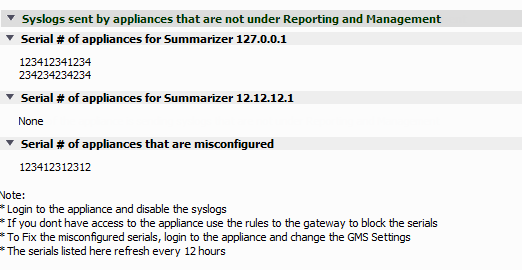The Summarizer Status page displays overall summarizer utilization information for the deployment including database and syslog file statistics, and details on the current status of the summarizer.
To reach the Summarizer Status screen, navigate to the Console panel of GMS and then to Diagnostics > Summarizer Status.
|
•
|
Summarizer: Displays the IP address of the Summarizer.
|
|
•
|
Estimated Capacity (million syslog/day): The estimated capacity of the system. This is calculated by taking the (average load per day) and dividing it by the (time spent), assuming that the Summarizer was to constantly summarize 24 hours (as in the case of a dedicated Summarizer).
|
|
•
|
Average Load (million syslog/day): The number of incoming syslogs per day.
|
|
•
|
Reporting Database Size: Displays the size of the reporting database in gigabytes.
|
|
•
|
Raw Data Directory Size: Displays the size of the raw syslog directory in gigabytes.
|
|
•
|
Estimated Cache Size: Displays the estimated size of the cache in gigabytes.
|
|
•
|
Backup Directory Size: Displays the size of the backup directory in gigabytes.
|
|
•
|
Status: Displays the status of the Summarizer. There are three different status notifications:
|
|
•
|
OK: The system is operating normally.
|
|
•
|
High Capacity: The average load is greater than 90 percent of capacity.
|
|
•
|
Low Disk Space: There is less that 5GB of space left on the disk.
|
|
NOTE: Not all syslogs are summarized. Some syslogs are discarded based on criteria defined at the Console > Reports > Syslog Filter and Unit > Reports > Configuration > Syslog Filter pages.
|
|
•
|
Data File Type: The type of files being reported on.
There are five main data file types: |
|
•
|
File Stats: The number of syslog files in the category and their size in Megabytes.
|
|
•
|
Oldest: The date and time on the oldest file in the category.
|
The Summarizer Process Details section shows what tasks the summarizer is performing at the moment the Console > Diagnostics > Summarizer Status page displays. Refresh your browser display or leave the page and return to it to update the information.





